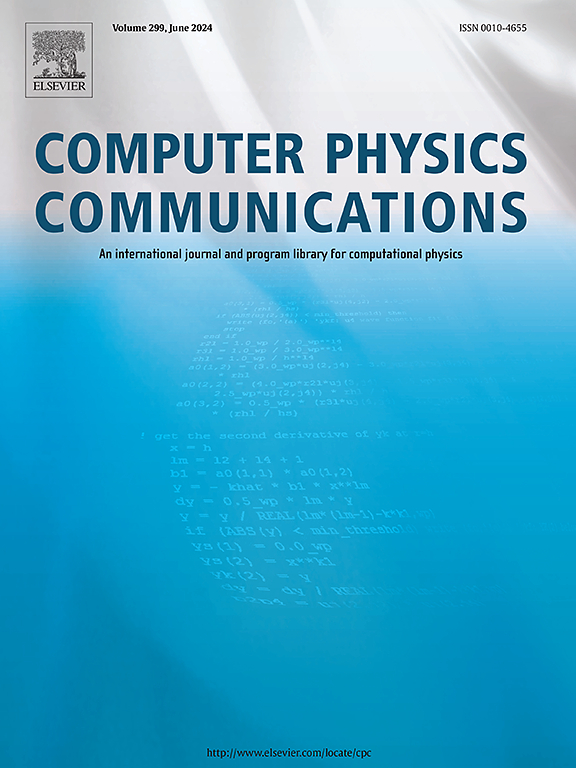基于块结构自适应网格的浸入边界晶格玻尔兹曼方法在cpu / gpu上模拟微粒流
IF 3.4
2区 物理与天体物理
Q1 COMPUTER SCIENCE, INTERDISCIPLINARY APPLICATIONS
引用次数: 0
摘要
将求解流体的晶格玻尔兹曼方法(LBM)和求解流固相互作用的浸入边界方法(IBM)结合到自适应网格细化(AMR)框架中,开发了一种高效的cpu / gpu求解器,用于粒子负载流的全分辨模拟。采用以细胞为中心的有限体积LBM方法保证质量守恒。采用边界加厚直接力浸边界法捕获固体表面,既满足无滑移和无渗透边界条件,又保持计算简单。AMR算法在开源框架AMReX上实现,其中固体只放置在最细的层上,不同的层以不同的时间步长推进解,大大降低了计算成本,提高了稳定性。通过优化和具体选择BoxSize,所开发的求解器在多达128个gpu上实现了97.95%的弱缩放效率。与均匀网格相比,在3级AMR网格的情况下获得了18.2倍的加速,同时减少了97.4%的内存使用。几个经典案例也验证了求解器的有效性,包括流过一个二维固定/振荡圆柱,流过一个三维固定球体,以及颗粒以稳定和不稳定的模式自由沉降。定性和定量结果表明,该高效求解器对于计算成本较高的复杂颗粒流具有良好的精度、鲁棒性、可扩展性和可扩展性。本文章由计算机程序翻译,如有差异,请以英文原文为准。
An immersed boundary lattice Boltzmann method on block-structured adaptive grids for the simulation of particle-laden flows on CPUs/GPUs
We developed a highly efficient CPUs/GPUs solver for the fully resolved simulation of particle-laden flows by combining the lattice Boltzmann method (LBM) for fluid and the immersed boundary method (IBM) for fluid-structure interaction into the framework of adaptive mesh refinement (AMR). The cell-centered finite volume LBM method is adopted to guarantee the mass conservation. The boundary thickening direct force-immersed boundary method is used to capture the surface of solids to satisfy the no-slip and no-permeability boundary conditions while retaining computational simplicity. The AMR algorithm is implemented on the open-source framework AMReX, where the solids are placed only on the finest level, and different levels advance the solutions with varying steps of time, greatly reducing the computational cost and improving stability. The developed solver achieves 97.95% weak scaling efficiency on up to 128 GPUs by optimization and specific selection of BoxSize. An 18.2-fold speedup is obtained in the case of 3-level AMR meshes, compared to that on a uniform mesh, while reducing memory usage by 97.4%. Several classic cases also validated the solver, including flow past a two-dimensional fixed/oscillating circle cylinder, flow past a three-dimensional fixed sphere, and particles freely settling with stable and unstable patterns. The qualitative and quantitative results show that this highly efficient solver has good accuracy, robustness, scalability and extensibility for the complex particle-laden flows conventionally with heavy computing cost.
求助全文
通过发布文献求助,成功后即可免费获取论文全文。
去求助
来源期刊

Computer Physics Communications
物理-计算机:跨学科应用
CiteScore
12.10
自引率
3.20%
发文量
287
审稿时长
5.3 months
期刊介绍:
The focus of CPC is on contemporary computational methods and techniques and their implementation, the effectiveness of which will normally be evidenced by the author(s) within the context of a substantive problem in physics. Within this setting CPC publishes two types of paper.
Computer Programs in Physics (CPiP)
These papers describe significant computer programs to be archived in the CPC Program Library which is held in the Mendeley Data repository. The submitted software must be covered by an approved open source licence. Papers and associated computer programs that address a problem of contemporary interest in physics that cannot be solved by current software are particularly encouraged.
Computational Physics Papers (CP)
These are research papers in, but are not limited to, the following themes across computational physics and related disciplines.
mathematical and numerical methods and algorithms;
computational models including those associated with the design, control and analysis of experiments; and
algebraic computation.
Each will normally include software implementation and performance details. The software implementation should, ideally, be available via GitHub, Zenodo or an institutional repository.In addition, research papers on the impact of advanced computer architecture and special purpose computers on computing in the physical sciences and software topics related to, and of importance in, the physical sciences may be considered.
 求助内容:
求助内容: 应助结果提醒方式:
应助结果提醒方式:


